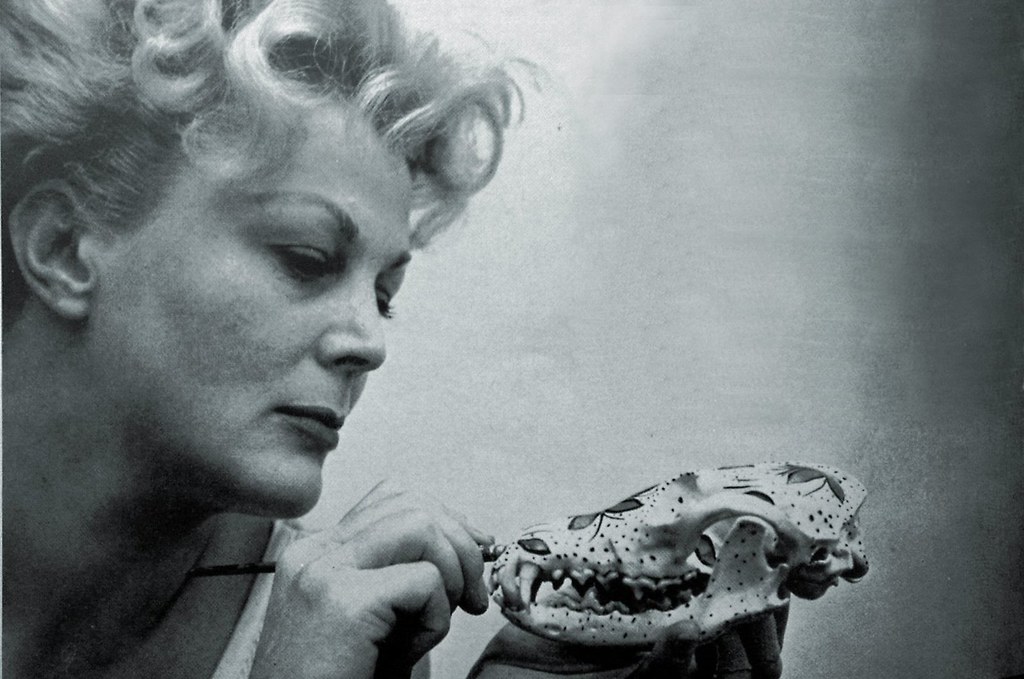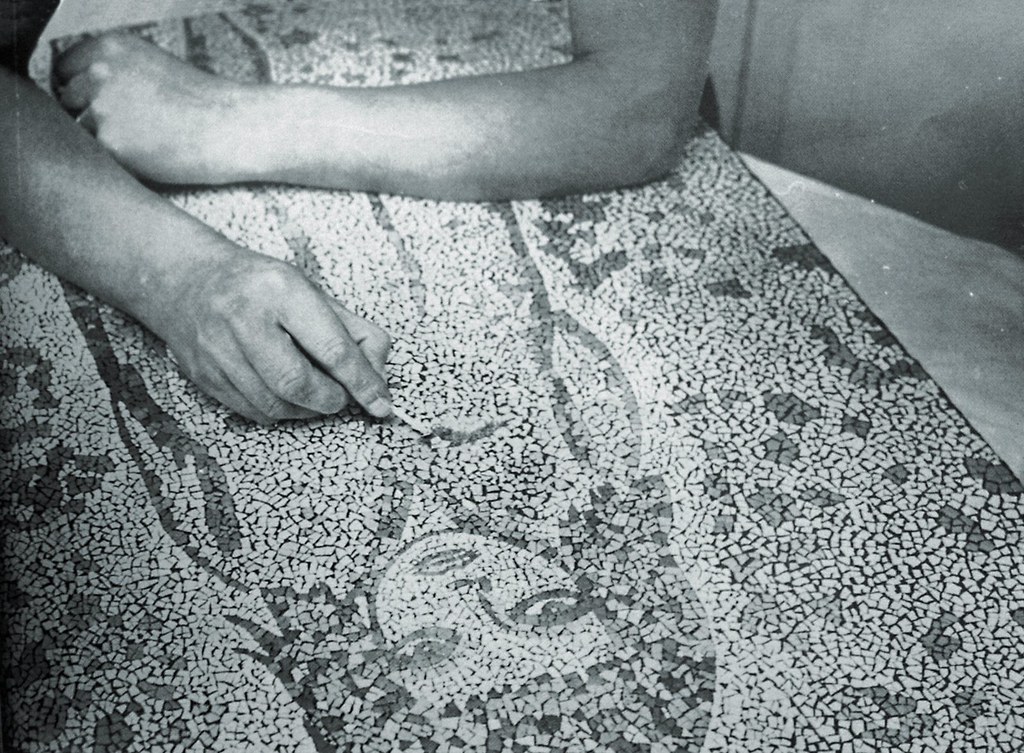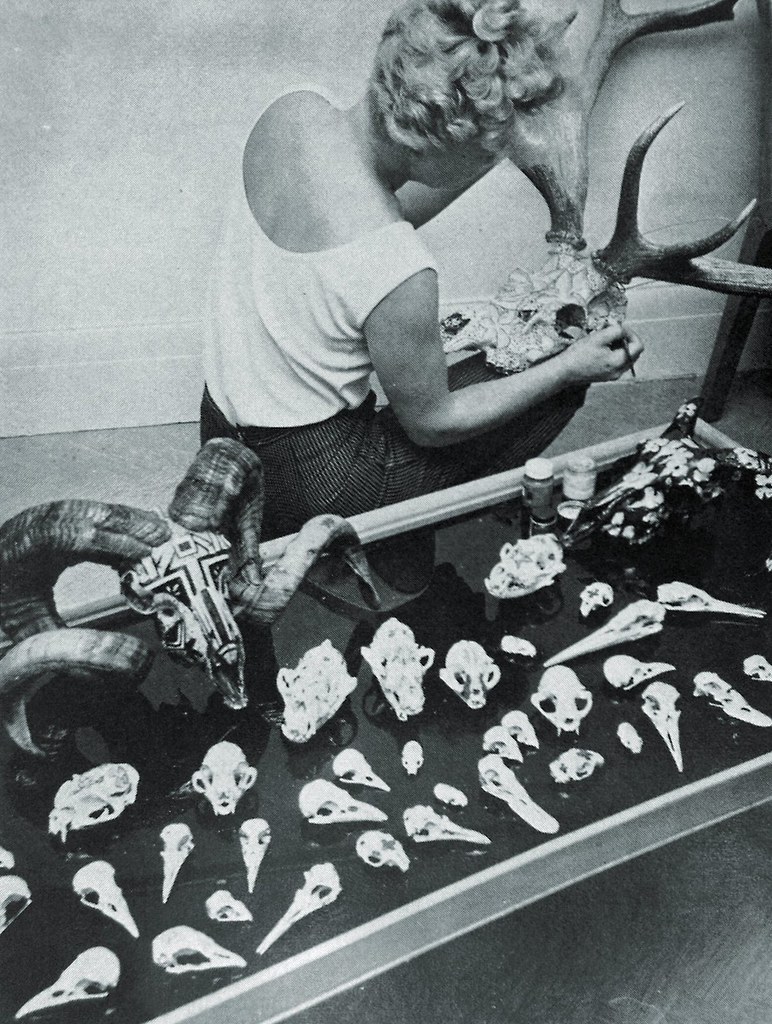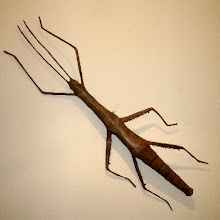Works of Art From Skulls and Eggshells
by Frank Martin South African artist Verna Hitchcock decided that she would like to make mosaic pictures from broken eggshells. "I was impressed with the natural colorings, which are impossible to reproduce with paints," she explained. "I remove the inner skin and stick then to the hoard with a special glue which bonds the shell to the hoard. I spend many hours in the country looking for discarded shells, and also receive regular supplies of shells from gamekeepers, etc., who are able to find the more rare eggshells."
South African artist Verna Hitchcock decided that she would like to make mosaic pictures from broken eggshells. "I was impressed with the natural colorings, which are impossible to reproduce with paints," she explained. "I remove the inner skin and stick then to the hoard with a special glue which bonds the shell to the hoard. I spend many hours in the country looking for discarded shells, and also receive regular supplies of shells from gamekeepers, etc., who are able to find the more rare eggshells."Interest was added and a new project undertaken when Miss Hitchcock, traveling the countryside in search of shells, began finding several skulls of animals (mainly rabbits, foxes, and birds). The artist immediately began to consider the possibility of creating beautiful works of art from these gruesome relics of death in the wild. After first cleaning the skull, she gave it a coat of light colored gloss paint. (This tends to create a porcelain effect and overcome the stark cruelty of the bone.) Next, Miss Hitchcock worked on the skull with enamel paints, decorating it with brightly colored designs.
Since her initial discovery, Miss Hitchcock has collected many skulls ranging from sheep and deer to swans and tiny ferrets. They uniquely adorn the mantel of her home in Hampstead, London.
 An admirer who had heard of her work recently sent Miss Hitchcock two giant elephant skulls as a gift, hoping that she can turn them into objects of beauty. The artist, contemplating her new project, says, "I will first have to fill in the cracks, and then give them a good scrubbing before starting to paint. However, they certainly present an interesting and different challenge!"
An admirer who had heard of her work recently sent Miss Hitchcock two giant elephant skulls as a gift, hoping that she can turn them into objects of beauty. The artist, contemplating her new project, says, "I will first have to fill in the cracks, and then give them a good scrubbing before starting to paint. However, they certainly present an interesting and different challenge!" EGGSHELL ARTIST
Click image to watch video
In 2009 she displayed the bulk of her work at London’s Hellenic Center. This was supposedly the first public exhibition of her work, although the British Pathe film seems to indicate otherwise. The April edition of the Marylebone Journal included this article about Ms. Hitchcock and her work.
April / May 2009, pp 30-31
EXHIBITION OF A LIFETIME
Verna Hitchcock
7 April – 5 May
(Closed 10–13 April, 17-19 April, 4 May)
Mon-Fri 10am-6pm
Sat-Sun 12pm-5pm
Private view 22 April, 6.30pm-8.30pm
Hellenic Centre
16-18 Paddington Street
020 7487 5060
helleniccentre.org
The idea behind Verna Hitchcock’s amazingly detailed egg shell mosaics came very suddenly. “I found a whole load of magazines that somebody had thrown out,” she says. “In one of them there was a picture of an Etruscan woman. I was looking at this image and from nowhere I just thought, gosh that would look lovely in egg shells. I got so excited that I picked up the phone straight away and said to the chappie at the grocery store: ‘How many eggs have you got? Send me about three dozen, but make sure you mix up the colours; the whites and the browns.’ He thought I’d gone mad, but I said: ‘Just deliver them.’ And that’s where it started.”
Another time she found a company that made lightbulbs with bright colours baked onto the bulbs. They sent her huge black bags filled with old fused bulbs which she smashed up with a hammer and used to make wonderfully colourful mosaics. Recently she has been experimenting with pea shingles – small stones used for laying pathways – which she has used to create a striking portrait of a young protester in Trafalgar Square. Any material she finds – fabrics, wallpaper, copper piping – she’s sees as a potential medium for her pictures rather than as everyday rubbish.
Verna’s apartment is full to bursting with paintings and objects – large, framed pictures hanging on the wall or just stacked up in piles; glass bottles that she’s covered in plaster then varnished and painted; Japanese dolls that she’s housed in elaborate cases. She has boxes full of the most beautiful stones, found on beaches, which she has covered with shoe polish and buffed to a shine, and extraordinary fossils – huge ammonites and belemnites – uncovered on Whitby Bay. The whole place is an Aladdin’s cave of artist’s materials, works in progress and hundreds and hundreds of finished pieces.
Verna herself remains something of a mystery – she’ll talk happily about her work, but she gives away very little about her past. She was born and raised in South Africa, but has been in the UK for many years. “I ran away really,” she says. When she was young she was an athlete – a high promising sprinter – before discovering “boys and cigarettes”. That’s about all she’ll say. The only other clues come from some faded old photographs, letters and press cuttings mounted on a board in her apartment, including a hand-drawn cartoon sent to her by Alfred Hitchcock. She had read in a newspaper that the only thing the film director was afraid of was eggs, so she wrote to him about her mosaics and sent him some cuttings. He sent her back the cartoon and a note saying: “I am glad about my disinterest and your interest in eggs.”
Now, for the very first time, people other than visitors to Verna’s unusual little flat will have the opportunity to see the fruits of a lifetime of loving labour. Despite being hugely prolific and obviously talented, she has never previously had any desire to show her work in public. “Most artists create 20 pictures then hold an exhibition, then make another 20 and hold another exhibition. I never did that. I was happy, I just lived with them and they were mine. But then I thought, damn it, I need to hold an exhibition. I want other people to see my work.”
The result is a remarkable event being held at the Hellenic Centre throughout April, at which Verna will finally bring her life’s work blinking into the daylight. But it’s not like most private shows – Verna has never sold a piece of art, nor does she ever intend to. Her exhibition is meant as nothing more than a way of sharing her work with the outside world. It’s a brave, highly individual, charmingly eccentric act – a reflection, if ever there was one, of its creator.
The photos from the show, or at least thumbnails, are viewable here (click the arrows in the upper right part of the frame) and here. The pictures are small, but you can get an idea of how cool these are.








Love your blog Brian! Amazing work...you answered so many questions I had...thank you and the links to view her photos are gone?
ReplyDeleteHey is Verna still alive ? My Granmother is her Sister. Didnt even know my Gran had a sister.
ReplyDeleteI am excited to see this artist and would love to see more of her work. I make eggshell mosaics and am happy to see someone has been doing such beautiful work with eggshells.
ReplyDelete